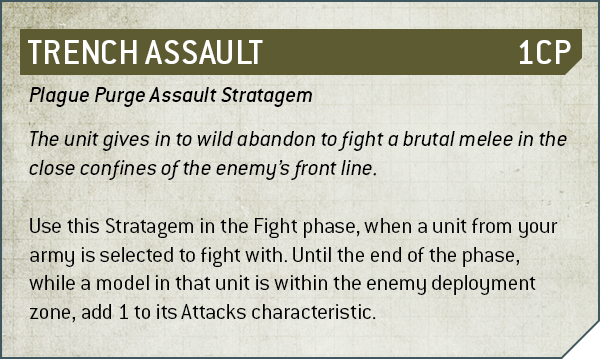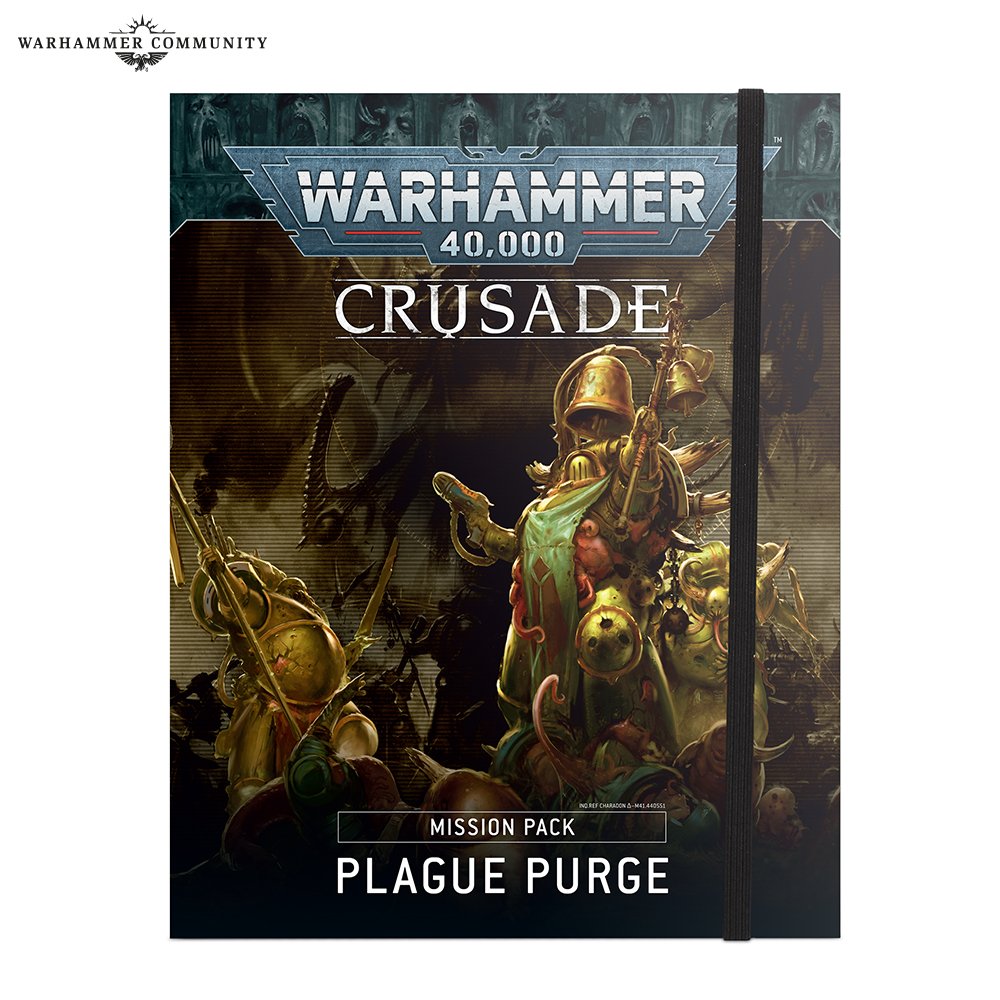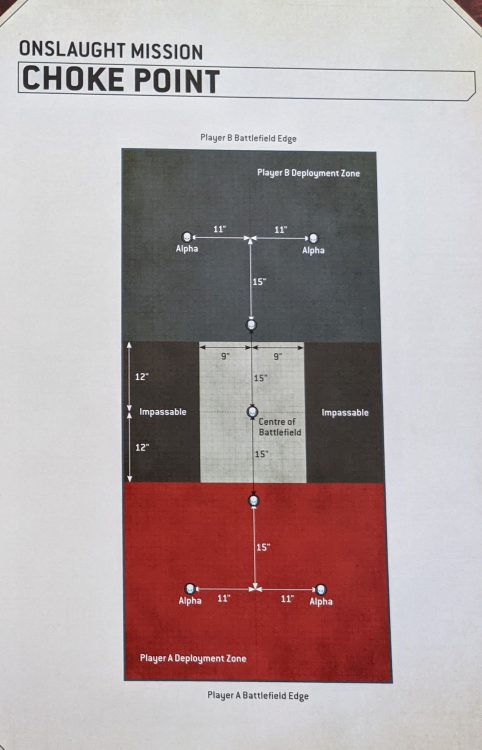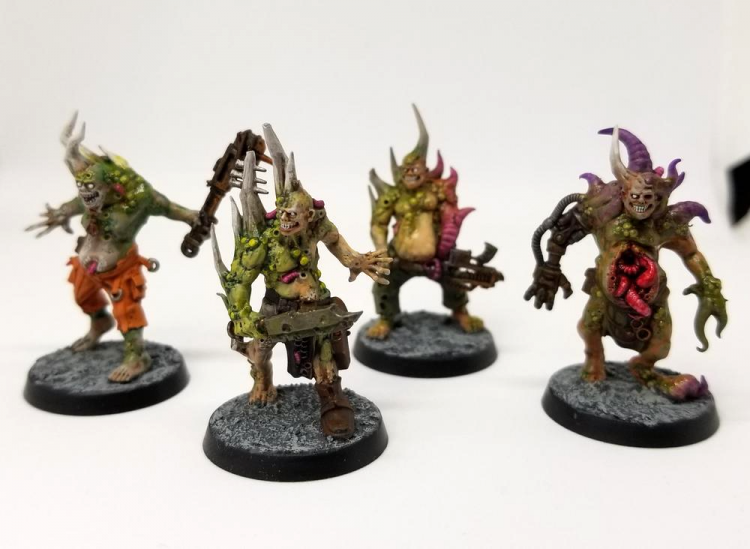Although it wasn’t included in our preview materials a few weeks ago, we’ve finally gotten our hands on Plague Purge, the newest Crusade expansion for Warhammer 40,000. And in our quest to devour and review everything Narrative-related in 40k, we’re sitting down with the book to talk about it today. Is it worth your time? And how does the entire Charadon campaign stack up so far?
As usual, we’ll be taking more of a round table approach to our review, with the usual crew of Beanith, Condit, Greg, and Rob weighing in on these rules and the Charadon campaign.
What’s in the book
Similar to Beyond the Veil, Plague Purge lays out new Crusade rules for games happening in the Charadon Warzone. Plague Purge gives us new Agendas, Requisitions, stratagems, and 24 new missions (6 each for Combat Patrol, Incursion, Strike Force, and Onslaught games). Unlike Beyond the Veil, the rules for Plague Purge doesn’t give us any Battle Traits, Scars, Relics, or a custom mechanic like Investigation (stratagems replace these rules – more on those in a bit). Also, they’ve reprinted the core rules here again. Helpful, right?
Rob: Actually no, not so much. Listen, GW. I don’t need the core rules in this handy book. You know what I need? The Crusade Rules. Start printing those in these books, so I don’t have to go back to the big, hardcover Core Rules book every time I want to reference the core relics, battle scars, and requisitions. Or at the very least, give me a softcover version of just those rules. What I don’t need is yet another book with the Core Rules in them that you’ll have to issue a separate FAQ for because each one has different page numbering.
Anyways, let’s talk about the contents.
Agendas
Rob: We’re given new Agendas to work with in Plague Purge; it’s unclear whether they’re meant to be additive to or replace those in the Core Rules. My gut says additive, but some are reprinted here. There are 20 Agendas here in total. Among the new Agendas are Calculated Eradication in Purge the Enemy, which rewards you for destroying units within range of an objective marker, while There is Only War awards XP for killing more enemy units in a battle round than the opponent. There are two new Battlefield Supremacy Agendas – Critical Position has you pick an objective marker and gain XP for holding it at the end of the battle, and Centre Secured wants you to hold the center of the battlefield. Otherwise, the remaining agendas in these categories are Core Rules reprints.
What’s completely new here are the Shadow Operations Agendas – All three of the Shadow Operations Agendas have been replaced here as well as one of the Warpcraft Agendas. And these are actually among the more interesting mechanics of Plague Purge:
- Secure Supply Cache gives you an action to perform near objectives that can be done by any number of non-Aircraft/Fortification units), but only once per objective. Doing so is worth 1 XP per action, but the action is completed at the end of the turn for INFANTRY units and at the start of your next Command phase for other units.
- Sabotage Defences is an action that multiple Infantry units can attempt while within 1” of a terrain feature in your opponent’s deployment zone and outside Engagement Range of an enemy. It’s completed at the end of your turn. It’s pretty fluffy, but difficult to pull off.
- Investigate Malignancy is similar to Secure Supply Cache in that any non-Aircraft/Fortification can do it, but Infantry finish the task faster. It can be completed by a unit within 3” of the centre of the battlefield.
The new Warpcraft Agenda is Scry Malignancy, which gives you a WC 4 psychic action that can be done near an objective marker to score an XP.
Beanith: As Rob mentions, it’s not terribly clear here if the Agendas in this book replace the ones from the Big Rule Book or if you can still make terrible decisions in taking the old Shadow Operations agendas or simply power level your Psykers by taking the old Scry Battle Plans. All that said, Calculated Eradication is my pick of the bunch and will no doubt continue to be a bad pick to take against myself due to my habit of being easily distracted into moving away from the objectives.
Rob: Overall it’s hard to rate Agendas. They don’t really have a bearing on whether you win or lose games, so most of the time it’s just asking “how do you want to earn XP” and as a player you have to figure out how that will align with your intended unit growth, army, and game plan.
That said, what I do love about these agendas is the pair of Shadow Ops that give you actions that complete at End of Turn for Infantry and Start of Next Command phase for other units. This is a really neat idea, and something that I want to see them do more of, including considering it for competitive play. There’s also no reason it can’t be tied to specific Force Org slots or other factors like keywords. Having actions that Troops complete faster could be cool

Requisitions
Rob: There are six new Requisitions in Plague Purge that vaguely represent fighting in the Charadon war zone but are really more mechanical in nature:
- Veterans of Obolis (1 RP) – is used pre-battle to get a free Plague Purge Assault Stratagem (see below) once per battle in the next game without spending CP.
- Raiders of Obolis (1 RP) – is the same, but used to get a Plague Purge Recon Stratagem.
The value of these are tied to the mission and the Plague Purge stratagems but at their core they’re basically letting you trade RP for some very specific use CP. The best tradeoffs here are where you can spend 1 RP to get 2-3 CP (Advanced Scouting is the biggest value) but on the whole “having more CP” is probably not how you want to spend your RP, especially if you’ll be getting extra CP from a Crusade Points differential anyways.
- Adapt to Overcome (2 RP/3 RP) – is used after a battle and lets you swap out one of your unit’s Weapon Enhancements for another, different Weapon Enhancement it could have. If you’re buying an Enhancement from The Book of Rust, this costs 2 RP, otherwise it costs 3.
- Specialist Asset (1 RP) – is used when building your army for a game. It allows you to pick a unit and give it one Weapon Enhancement for a single battle (and increases its Crusade points accordingly).
- One More Into the Breach (1 RP) – is used after a battle, when you fail an Out of Action test for a unit that’s Battle-ready rank. They take a Devastating Blow but don’t lose any XP.
- Strength Through Suffering (1 RP) – is used before a battle to pick a unit that has any Battle Scars. While that unit has any battle scars, it gets +1 XP any time they earn any XP during the battle. You can only use this on one unit at a time and in order to use it again you have to remove all of the battle scars from the unit.
Beanith: I’m straight going to slap Strength Through Suffering on my poor little Hexmark Destroyer as soon as possible.Tasty extra xp to go with the Necron Battle Scars which are totally a bad thing..? Sign me up. As for the two that allow you to use one of the new Stratagems without spending CP? I’m not sure I’d ever want to waste precious Requisition points on something so pointless.
Rob: I really like Adapt to Overcome and Specialist Asset. I think they add a lot of cool optionality for your units and although I have mixed feelings about the Book of Rust tie-in (more on that later), it’s really easy to get weapon enhancements you don’t love, so I’m all for having the ability to change those. Strength Through Suffering is just cool, though.
Stratagems
Beanith: Along with everything else, we’ve been given 12 more Stratagems broken into two categories, Recon and Assault. Which set you get access to depends on which mission you are playing from The Plague Purge Mission Pack. Each one is single use per game only. Half of the missions for each game size use Recon, while the other half use Assault.

Recon
Beanith: These six stratagems are largely themed around movement and actions which will be very handy in clutch situations if you remember that they are available *spoiler – I don’t remember to stay on objectives most games so good luck future Beanith*
- Advanced Scouting (3 CP) allows you to deploy a unit within 6” of your deployment zone during deployment and 9” away from any enemy units. Doesn’t sound like much but could come in handy to stymie other units that can infiltrate during deployment if you play this early enough.
- Maintain Focus (2 CP) allows you to still shoot while performing an action.
- Selfless Prosecution (2 CP) is one I’ll probably need to tattoo to the back of my hand. It allows you to perform an action while within engagement range of the enemy even if it would normally fail.
- Swift Engagement (1 CP) lets you reroll one or both dice on a charge roll when targeting an enemy unit holding an objective. Handy if you’re not an Ork.
- Mental Concentration (2 CP) gives your Psyker a chance to be useful after spamming Psychic Actions and lets you cast an additional psychic power that turn.
- Lastly we have Rapid Advance (1 CP) which will give you that clutch 6” advance you invariably need at the expense of shooting and charging.
Rob: Holy shit why is Maintain Focus not a universal Stratagem? It’s something they’ve been sneaking into more Codexes and it’s kind of weird to make it a Crusade Stratagem. Put it in the core rules, cowards. Selfless Prosecution is also huge, since it “turns on” some actions that might not be doable, but not that it won’t let you get around restrictions that require an enemy be more than some distance away from an objective marker or other point on the table. Otherwise, these are cool in that they allow you to keep acting as you move or get the most out of your movement.
Condit: I don’t know how many games I’ve wound up wishing I had something approaching certainty that I could make that long-bomb charge onto an objective with my Bladeguard, and Swift Engagement is perfect to help give me that security. And Mental Concentration is a cool ability for armies who rely on psychic powers, potentially making it more likely that people will actually field their psykers.

Assault
Beanith: Oddly enough these six stratagems aren’t based around the Charge and Fight phases but are spread out across the game whilst still maintaining the Assault theme.
- Stand Ground (2 CP) means the unit holding that key objective didn’t fail that Morale test. Most importantly, it’s used after you fail the Morale test, so it’s a very good safety net if you’re not sure about spending 2 CP upfront for Insane Bravery. Condit: It also gives you a second auto-passed test per game, which is worth keeping in your pocket if you need it.
- Turn the Tide (2 CP) gives a unit being deployed the Objective Secure ability – this is a massive boost for armies that have large units of non-Troops Infantry.
- Inspired Command (2 CP) will increase a Character’s aura ability by 3” for one battle round.
- Dig In (2 CP) grants a (non-AIRCRAFT, non-TITANIC) unit deployed in your zone Light Cover which lasts until it makes any kind of move.
- Trench Assault (1 CP) adds +1 to the Attacks characteristic of a unit wholly within the enemy deployment zone.
- And lastly the slightly complicated Go to Ground (1 CP) which grants -1 to ranged hit rolls if your unit is in or partially in cover and then halves your movement until the end of your next turn.
Beanith: Selfless Prosecution is my clear favorite. This could win me a game or two if I remember it’s available. The number of times I’ve faced some brilliant pile in/consolidate moves from my opponents which prevented me from performing an action has gone on too long…
Condit: I like the focus here on objective play – these stratagems all seem tuned to help you move forward and play the objective. Turn the Tide in particular is my jam – being able to shove ObSec onto a melee threat like Bladeguard or Incubi could be pretty nasty and result in some clutch denial plays that aren’t otherwise likely.
Rob: Yeah, it’s a cool balance against the Recon stratagems. I also like the return of Dug-in Positions here, but for a single unit. It’s gonna be absolutely clutch for protecting key units on T1, especially if you’re playing on some of the flatter boards that Flashpoints: Charadon encourages.
Condit: Ugh. Don’t remind me.
Missions
Condit: The real meat of this book is the Missions section. With six new missions for each battle size, you’re spoiled for choice on games to play at any level. Different missions are scored differently, offering a choice between progressive and end-game scoring, with many missions having both.
There are also some pretty cool asymmetric scenarios here. One example is the Strike Force mission Ring of Steel, which gives the Defender a larger deployment zone and lets them choose a terrain feature in their deployment zone and either give it a new terrain trait or, if it already had Light Cover or Heavy Cover, improve that trait’s bonus to their saves by 1. In exchange, the Attacker automatically gets to go first and can place units into Strategic Reserves without spending CP. It sets up with four objectives: Two in each player’s deployment zone, with the Defender’s near the center of the map, and players score 4 points per objective for holding them at the end of their Command Phase, similar to the matched play missions. Adding a little complexity to this is that players also score 5 points per objective they hold at the end of the game, but only count the ones in the Defender’s deployment zone.
A few of the missions also put interesting twists on some familiar mechanics. Tech Recovery, another Strike Force mission, sees each player placing three objectives on the board in pretty standard fashion, then hands out points for performing an action to “uncover” one of the objective markers and additional points for holding those uncovered markers. There’s a twist, though: of each player’s three objectives, one is fake. It’ll still give you points for uncovering it, but you won’t be able to hang onto it to keep racking up points off of it.
The smaller missions are cool too. Tech Relic, the Combat Patrol version of Tech Recovery, has you roll on a table every time one of your units takes the Uncover Tech action and, on a successful roll, removes the rest of the objectives from the table and designates that one the “Relic.” It then turns into a game of Capture the Flag, with the two armies moving the relic around the board using the “Escort Tech” action. If you want something a bit more “normal,” Survivors of the Fallout offers a fairly straightforward objective control mission, with a simple twist: any time you shoot at a model within 9” of the center of the board, you’ll add 1 to the wound roll. And you won’t have to worry about getting mileage out of that, as there’s an objective conveniently placed smack dab in the middle of the map.
If larger missions are what you’re looking for, look no further than the Onslaught missions. Pandemic Outbreak is a six-objective mission where the players start removing objectives from the board beginning at the top of the second round, but the value of holding those objectives increases every turn. And while the first four to come off the board do so in pairs chosen by one of the players, the final one to be removed is selected randomly, potentially creating a tense situation as the players have to react to an evolving situation that may not turn out exactly as they’d planned. Or, if you’re looking for a more straightforward experience, consider Obolis Onslaught, which has you fighting over nine objectives, three of which are in each player’s deployment zone. You’ll gain more points for holding the objectives in your opponent’s deployment, and can pick up a cool 4 bonus points for every unit you have in your opponent’s deployment zone at the end of the game.
Many of these missions have similar counterparts at different points levels, but with slight differences to change things up from game size to game size. For example, each points level has a mission centered around the Uncover Tech action, but each one of the four has a slightly different scoring mechanic. Fortunately, the more complicated scoring rubrics seem to mostly be reserved for higher points-level games, which should help with acclimating newer players to how the game plays before overwhelming them with rules.
Rob: I’ll be honest – I was surprised at how much work went into making the Onslaught missions; each has custom deployment maps and there are a couple that are significantly mechanically different from any of the book’s smaller missions. Choke Point is by far my favorite of these, which introduces two massive, impassible parts of the battlefield that only flyers can pass over. I’m a sucker for missions that play with the table structure, though.
Beanith: My first few games have been a blast, I’ve enjoyed the new actions that most missions have and the new Stratagems will change how you approach the mission (assuming you can remember them). I’m pleased that they have moved away from the Invulnerable modifiers in Beyond the Veil and I would like to see more use of the Fallout Zone +1 to wound rolls on ranged attacks.

Credit: Pendulin
Is it any good?
Rob: We mentioned earlier that Plague Purge is missing several elements that were in the Beyond the Veil book. That’s not necessarily a bad thing – we’re certainly happy to see some differences between campaigns – but it does feel like those rules are still in Charadon, they’re just… in other books. Where Beyond the Veil felt like a self-contained book with some minor add-on content in White Dwarf, Plague Purge feels like it’s part of a multi-book release that needs The Book of Rust to really be complete.
Condit: I’m of two minds on this. On the one hand, having the content split between multiple books is always annoying, as if you’re like me and you want to do your inter-game bookkeeping immediately after each game, you’re going to have to lug the Book of Rust around with you in addition to your army’s rules, even if you’re not using anything from it that game.
That being said, there is some value to keeping them separate. First, any changes in later “Acts” of the Charadon campaign book series will still be able to use the Plague Purge missions, and with 24 of the things, most players won’t play through all of them by the time the next book drops, so there will still be plenty to explore.
Perhaps more importantly, though, splitting things up like this creates some space for new and aspiring campaign masters to hack together their own rules and build the campaigns they and their friends want to play. If you’ve read any of our other Crusade reviews, you’ve probably noticed that Rob and Beanith frequently mention that they’re interested in taking certain rules from a particular supplement and mixing them in with other stuff. And while you can certainly do that, if you’re not as comfortable hacking together your own ruleset or just don’t have the time to get to where you’re happy with it, splitting the Crusade rules up into different books for what you need at the table and what you’ll need between games could be a useful tool in building your own campaigns.
Rob: Yeah I get that some people will just play these straight, though still having to get relics and enhancements from the Book of Rust seems like a miss to me. On the whole I like these rules though, and it seems like a lot more work went into these missions than Beyond the Veil’s (though I thought the ones in BTV were also interesting).
Beanith: For the most part, yes. As it’s been touched on, having all the Relics/Battle Traits/Scars etc in the Book of Rust or in issues the White Dwarf does make life more difficult but on the other hand, these missions are pretty damn cool.
Final Verdict:
Rob: Ultimately I think Plague Purge is another strong entry, and worth picking up if you’re already planning to get the Book of Rust. You’ll definitely want to get both if you’re planning on getting Plague Purge, though. Also, check to make sure your group is also interested in picking this up and playing it before you grab it. It’s not crazy expensive, but with two Crusade books out already I’m not sure most players who got Beyond the Veil played more than a couple games of it, let alone enough to want to move on to a new campaign yet.
Condit: I like this book a lot, and in particular the missions themselves. I’d sort of disagree with Rob that you definitely want both this and Book of Rust, though: I honestly think a good number of these missions are worth playing as one-offs if you haven’t decided to take the plunge and play in (or run!) a full-on campaign.
Beanith: I’m a big fan and would recommend adding this book and the Book of Rust to your pile of books to lug around for future Crusade games. I love how it’s been simplified down from Beyond the Veil where you also had to deal with the Strategic Setbacks and Afflictions tables. As we’ve noted in the Charadon Flashpoints reviews, more tables doesn’t actually make the games more fun.
That wraps up our look at Plague Purge, but you better believe we’ll be back in a week or two to review the next Crusade release for 40k – probably Flashpoints: Charadon in next month’s White Dwarf. In the meantime, if you have any questions or feedback, drop us a note in the comments below or email us at contact@goonhammer.com.




